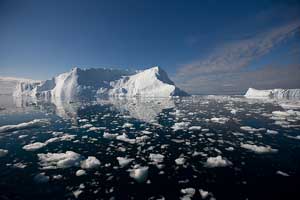
Photo by James Balog, the Extreme Ice Survey.
“I don’t really know what a ton of carbon dioxide looks like.” US Representative Michael Burgess, R-TX, during markup of HR 2454, House Committee on Energy & Commerce.
It should surprise no one that Representative Burgess voted against the American Clean Energy and Security Act of 2009 (ACES) when the historic climate bill narrowly passed the US House, just a day or so after the Texas Republican complained that he couldn’t see the offending green house gas. If you can’t see it; how do you know it’s real?
Now there’s help for all those people who, like Rep. Burgess, are firm believers in the old maxim, “Seeing is believing” (and in its corollary, “Not seeing is not believing”). It couldn’t have come too soon, as the Senate begins new hearings this week on a climate bill of its own.
Photographer James Balog and his colleagues at the Extreme Ice Survey, used time-lapse photography to create a moving (in both senses) video of glaciers receding before your eyes.
Even if you’re the kind of weirdo who analyzes data or, say, can determine if something is true or not simply by reading a few books, the video is compelling. It gets to you at a visceral level.
Maybe Harry Reid should declare movie night at the Senate sometime soon. That way, members can screen James Balog’s astonishing video — before voting on a climate bill.
There is precedent for a successful “movie lobby.” In April 2006, President Bush was so enthralled by a documentary filmed by Jean-Michel Cousteau, about the beautiful but unprotected 1,200-mile-long Northwestern Hawaiian Islands, that two months later the president designated the entire area a national monument. It was only the second such designation Bush had made since taking office five-and-a-half-years earlier.
The United States Senate passing a bold yet reasonable bill to fight global warming. Now, that I’d like to see.
Note: Support “Watch The Video” to get Senate screening. Tweet #WTV with your reason why Senators should see this video. Include URL http://bit.ly/199utV.
Sample: Because seeing is believing! Pass a climate bill now. http://bit.ly/199utV #WTV Plz RT!
————-
Osha Gray Davidson is a contributing blogger at Mother Jones and publisher of The Phoenix Sun, an online news service reporting on solar energy. He tweets @thephoenixsun.














